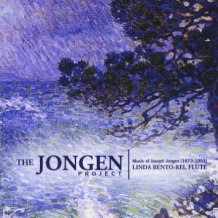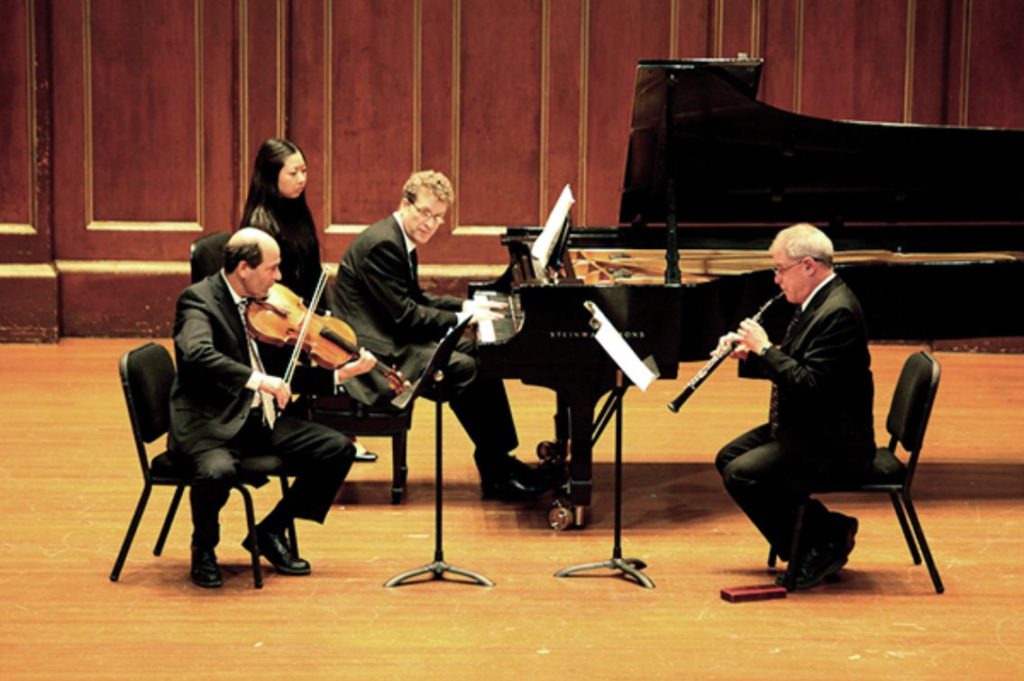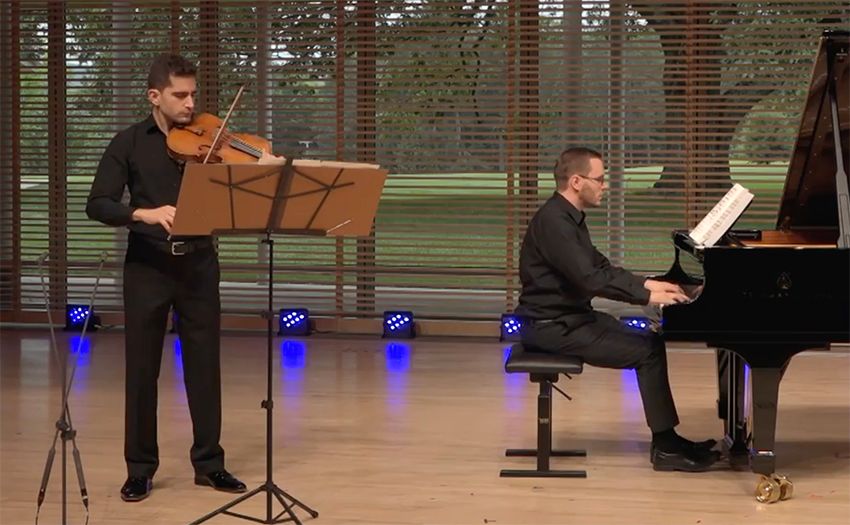Release Date: January 12, 2022
".......Your CD arrived yesterday. It’s terrific, Linda: technically extraordinary and consistently expressing a great vitality and a warm and intense enthusiasm. One wouldn’t think a pairing of flute and Latino percussion would work, but it does. For some of the material I had no sense of structure, but it didn’t matter—your playing was what I wanted to hear, and was rewarded. I especially liked the Tango Etudes—a rich fullness of fine flute sounds, particularly in the Lento (#13)—except for much of the time not knowing which flute was yours. One thing which impressed me, and which I hadn’t heard in your recordings before this one, was the variety of sounds you got—at one extreme broad and generous, at the other pointed and focused, and some in between."
"......Your new recording arrived earlier this week — thank you! It's really marvelous. Brava to you on your incredible discography. It's truly impressive and I have so much respect for the work and the inspiration it takes to produce something so compelling!"
"......The first Piazzolla on the CD, you got the feeling just right - it was so sexy....You mastered such tone differences on same notes, it could almost have been two different flutists, but you did it all. You fly over all octaves so gracefully and all your notes are exquisite. The Paquito I loved. The marimba adds so much and it's nice to have other accompanists other than piano. All of your additional players added so much too. They also did a great job. I loved the 3rd mvt of Nemisis. I don't know how you mastered the ping-pong effect with the marimba - masterful! I love it - great job."
".......I found your new CD very comforting to listen to!"
Flutist Linda Bento-Rei’s New CD
by Geoffrey Wieting
It is not uncommon for gifted artists to explore beyond the boundaries of their own “proper” repertoire. Classical music has a long list of such people, both composers and performers. Flutist Linda Bento-Rei is one such, as she continues to demonstrate on her new CD, “Radically Traditional”. Working with a marimbist inspired her to examine tangos as well as classical pieces with significant Latin influence. Ultimately, she settled on six pieces composed between 1950 and 2010, all of them adapted in some way: for some she envisioned the arrangement herself, while for others her collaborators made their own arrangements. While the composers are from different countries (one even from the U.K., not an expected source of Latin-influenced music), the common thread of the pieces on the CD is fusion of styles, with the tango being the form most prominently featured.
All the artists have deep Boston connections. Bento-Rei, though now based in Florida, grew up in Massachusetts and received her degrees in flute performance in this city, from Boston and New England conservatories. She has made all of her recordings locally, at WGBH-FM’s distinguished Fraser Performance Studio. All of her collaborators on this disc—marimbist Michael Weinfield-Zell, percussionist Bertram Lehmann, oboist Andrea Bonsignore, clarinetist Bruce Creditor, bassoonist Richard Ranti, and French hornist John Michael Adair—reside, perform and/or teach locally.
Bento-Rei, Michael Weinfield-Zell, and Bertram Lehmann begin the program with a piece by world-renowned Argentinian composer Ástor Piazzolla, a fine representative of this recording’s raison d’être : the “intersectionality” of tango, jazz, and classical music. His Escualo (Shark), completed in 1979, is a famously demanding fusion of these three genres, originally written for solo violin. It is a fine testament to Bento-Rei’s visionary skill that to the average ear this version for flute, marimba, and cajón (a box-shaped percussion instrument) sounds utterly right. This delicious piece is organized around a fast candombe rhythm: in a bar of eight pulses, accents are placed on the first, fourth, and seventh, leading to a syncopation within a “regular” meter (3+3+2). The marimba and cajón set the pattern, and the flute riffs imaginatively off it. This may be no more than a musical souvenir of Piazzolla’s enjoyment of hunting the escualo while vacationing in Punta del Este, Uruguay; on the other hand, there is a brief passage wherein the marimba gets to shine while the flute executes a slippery up-and-down chromatic figure, perhaps showing that the shark is not easy to catch!
Another preëminent figure in South American music is, of course, Heitor Villa-Lobos. He wrote his three-movement Assobio a Jato (The Jet Whistle) in 1950 for flute and cello—the marimba here taking the place of the latter. The marimba initially gets the melody before the flute takes it over with ever-increasing complexity. Bento-Rei handles the flute cadenzas with skill and panache. Despite considerable fluctuations of tempo and rhythm, the fine rapport between the two performers remains unaffected. In the second movement the flute mostly stays in its low register, intimately singing an affecting, mournful tune over tremolo marimba chords. The unresolved final chord leads straight into the third movement. Weinfield-Zell here establishes a walking figure in the marimba as Bento-Rei plays an angular melody with increasingly elaborate flourishes. After a calm middle section, the opening material returns with the flute flourishes becoming still more brilliant. Following a sequence of fast rising figures, Villa-Lobos has the flutist produce the piece’s eponymous sound by blowing forcefully and directly into the flute with her mouth nearly covering the mouthpiece; when combined with a “glissando”, the resulting whistle effect simulates a jet taking off.
In 1960s Argentina, Piazzolla launched a reinvigoration of Argentina’s “national” music, that he derived from his formula of “tango + tragedy + comedy + whorehouse.” This “new tango” (as it became known) received, of course, strenuous objections from conservative tango purists. However, the composer also spent time in his hometown of Mar del Plata to investigate its famous folksong and dance, the milonga. The CD’s next item, lacking the theatrical extremes of the new tango, is an example of the latter endeavor: Milonga sin Palabras (Milonga without Words). Piazzolla wrote this work for his wife, scoring it for bandoneón (a button accordion closely associated with the tango); it is arranged here by William Scribner for wind quintet. Bento-Rei is joined by oboist Andrea Bonsignore, clarinetist Bruce Creditor, bassoonist Richard Ranti, and French hornist John Michael Adair. The bassoon, clarinet, and flute begin by setting up a repeating sequence of five chords and establishing a melancholy, world-weary mood. A succession of different melodies occurs over the chord pattern, shifting among different instruments, sometimes with one completing a phrase begun by another. Different registers are contrasted: e.g., one passage of closely grouped lines gives way to a flute line soaring high above, not unlike a soprano’s operatic aria. All the musicians are sensitive to their different roles, each taking the spotlight when assigned the tune and then gracefully yielding it to the next. The one significant break from the comfortable mainstream occurs near the end when after some minutes of centering around F minor, the tonality abruptly switches to the distant key of C# minor, remaining there through the unison ending. The artists manage the neat trick of making this music sound romantic—without any starry-eyed illusions.
Linda Bento-Rei continues to be a persuasive advocate for Andy Scott, a British composer born in 1966. His Paquito, a tribute to the brilliant composer, saxophonist, and clarinetist Paquito D’Rivera, is a “fast salsa based around a two-three clave pulse”, originally scored for 12 clarinets, arranged by Scott later for flute and harp, and here reimagined by Bento-Rei for flute, marimba (Michael Weinfield-Zell), and bongos (Bertram Lehmann). Paquito is a lively dance full of fun and syncopations. The three instruments’ rhythms sometimes align but mostly are independent, playing off each other; the performers make it sound entirely natural and easy. Amid the Latin festivities there appears (twice) a completely unexpected classical reference—a quick quote of C. P. E. Bach’s Solfeggietto, a piece familiar to most intermediate piano students—and, amazingly enough, it works!
On a much larger scale is Scott’s other piece on the CD, Nemesis (I long to know what inspired that title), comprised of three parts and scored originally for soprano saxophone and vibraphone, subsequently arranged by Scott for flute and harp, and here presented by Bento-Rei for flute and marimba. If the preceding piece was brimful of Latin stylings, this one is almost entirely free of them but is an elegant piece of fin de siècle (that is, 20th century!) jazz. In Part I, the flute initially spins out long legato lines over the marimba’s parallel fifths in swaying rhythms, though a more animated passage soon develops. In a central section the mood turns reflective, but a long, well-judged accelerando brings us back to the original theme with the flute playing it an octave higher than at the opening. A brief coda builds intensity to the ending “shout”. Part II features a sober, searching flute melody over punctuating marimba chords: Bento-Rei and Weinfield-Zell create a gentle, evocative atmosphere. A slow-motion marimba cadenza sets the tonality adrift, but the flute’s insistent single note brings it home. One more quick key detour occurs before the warm ending in F major. The opening of Part III grabs the attention immediately with the two instruments in unison playing melodic fragments, mosaic-style. As always, the ensemble of the two artists—even when anchoring rhythmic patterns are virtually absent—is exemplary. At length, an identifiable tune emerges in the flute over a rhythmically jazzy marimba chord sequence. Bento-Rei gives us an expressive, improvisatory flute monologue. A later highlight is the recapitulation of the opening “mosaic” texture, which provides the basis for the exuberant final phrases.
Piazzolla wrote his six Tango-Études near the end of his life (he died in 1992), which possibly explains why this music is more exploratory than his other, earlier pieces heard on this disc, though this set could not be called avant garde by any means. He wrote the études for solo flute or solo violin, but here we hear an arrangement of them by Exequiel Mantega and Paulina Fain for two flutes and “world percussion” (something of a catch-all phrase meaning a variety of percussion instruments, some familiar to the layperson, some not). The conventional meaning of “étude” is a piece testing the technical prowess of the performer, but here Piazzolla seems to intend as more cerebral meaning of “study” as he explores just how far he can stretch the concept of “tango” (though certainly some of these also challenge the performers’ technique). As before, if one didn’t know the composer’s first scoring, the arranged version would be quite convincing as original. Bento-Rei joins forces with Fernando Brandão, a flutist of comparable skill and sensitivity, and Bertram Lehmann playing the various percussion instruments. The first Tango-Étude, Decidido (Decided), features the two flutes delectably intertwining and frolicking within a tango rhythm well-defined by the percussion and resembling the candombe pattern heard in Escualo. As the piece proceeds, the tempo and intensity steadily increase, as does the technical display, leading to an emphatic, rapid-fire ending. The title of the second, Ancioso y Rubato, is enigmatic: if Spanish (ansioso) it means “anxious”; if Italian (ancioso) it means “angry”. Yet neither emotion would seem to apply to the graceful music heard here. Both flute parts are sustained and caressing, one simple and sustained, the other more florid and ornamented. Bento-Rei and Brandão have a clear simpatico, staying well synchronized through a great many rubato-inflected phrase endings. Though the performers sustain quite a slow tempo, the music recalls the intimacy of tango dancers and builds drama to a high point before the opening theme returns. Lehmann uses a variety of percussion instruments to lend color and atmosphere throughout this quasi-timeless piece. The third étude is more conventional, though it does make use of a “flute percussion” effect closely related to Villa-Lobos’s “jet whistle”, the only extended technique employed by Piazzolla on this CD. This fast dance has a capricious quality and conveys an infectious enjoyment, ending with a burst of energy. The fourth (Lento-Meditativo), not quite as static as the second, is a meditative lamentation with the flutists pouring out gloomy melody, enhanced by sparing use of pitched percussion. At several points Bento-Rei and Brandão play in unison and without vibrato to moving effect, particularly at the haunting final cadence. The fifth Tango-Étude (Allegro) returns to high spirits with a jaunty bongos beat and friendly competition between the two flute parts. Again Piazzolla makes use of the quasi-jet whistle effect (though more staccato than Villa-Lobos’s). A short rising sequence brings us to a playful ending. The final piece is also oddly named (Avec anxiété) unless “anxiety” is defined as nervous energy. It is still more of a showpiece than the previous étude, featuring brilliant duetting frequently punctuated by the “flute percussion” effect. The much calmer middle section, beginning and ending in the two flutes’ satin-smooth low registers, recalls somewhat the lamentation of the fourth étude. The recapitulation of the first theme ultimately works up to a climax, both flutes momentarily suspended at the peak, then twin downward cascades finish the work in dazzling fashion.
Linda Bento-Rei and her fellow artists on this CD make a strong case indeed that a large body of music exists that is not composed for flute but capable of being convincingly adapted for it by using intelligent arrangement techniques and, of course, superb performances. I feel grateful to all involved in this recording for demonstrating this so enjoyably.
Geoffrey Wieting holds Bachelor’s degrees in organ and Latin from Oberlin College and a Master’s degree in collaborative piano from New England Conservatory. He is Organist of First Parish Church of Weston as well as a freelance organist, collaborative pianist and vocal coach. He sings with the Back Bay Chorale and serves on the Board of Directors of the Old West Organ Society.
.jpg)

















.jpg)


.jpg)





.JPG)






 Pianist Randall Hodgkinson performs with the Boston Symphony Chamber Players. Photo: Hilary Scott
Pianist Randall Hodgkinson performs with the Boston Symphony Chamber Players. Photo: Hilary Scott
 Pianist Jonathan Bass. Photo courtesy Boston Symphony Orchestra
Pianist Jonathan Bass. Photo courtesy Boston Symphony Orchestra
 Pianist Brett Hodgdon accompanies BSO violist Daniel Getz in a performance of Paul Hindemith’s ‘Sonata for Viola and Piano,’ Op. 11, No. 4 at Tanglewood’s Linde Center for Music and Learning. Photo courtesy Boston Symphony Orchestra
Pianist Brett Hodgdon accompanies BSO violist Daniel Getz in a performance of Paul Hindemith’s ‘Sonata for Viola and Piano,’ Op. 11, No. 4 at Tanglewood’s Linde Center for Music and Learning. Photo courtesy Boston Symphony Orchestra




